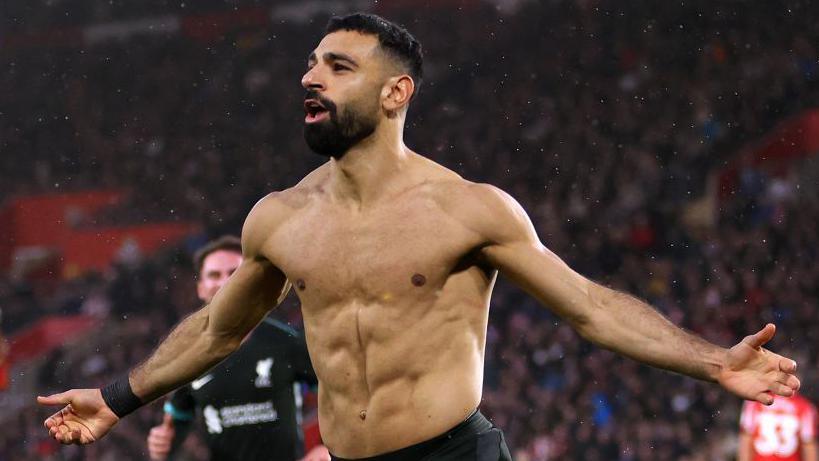
The photo of Mohamed Salah posing happily in front of a Christmas tree alongside his family ignited unexpected controversy on social media. Fans were taken aback by the image, leading to a passionate discussion within the Muslim community. For some, this celebration represents a clash between cultural norms and personal expression.
Salah, a global icon and role model for many Muslims, found himself at the center of a storm. The backlash has highlighted the strong opinions held by a segment of his followers, illustrating the complexities that come with fame and cultural expectations.
This article will delve into the reactions surrounding Salah’s Christmas photo, exploring the cultural and religious sensitivities that inform these responses.
Section 1: The Photo and the Initial Outcry
The Image Itself: A Detailed Description
In the now-famous photograph, Salah smiles broadly in front of a brightly decorated Christmas tree. His family stands beside him, radiating joy and warmth. The festive atmosphere contrasts sharply with some of the beliefs held within parts of the Muslim community.
Social Media Reactions: A Snapshot of the Debate
The photo stirred a wide array of reactions on social media platforms. Tweets and comments poured in, with some users expressing disappointment. Some estimates suggest that within the first 24 hours, the post garnered thousands of comments, with roughly 30% articulating disapproval. Phrases like “disappointed in you, Salah” trended, showcasing the level of scrutiny he faced.
Early Media Coverage: Setting the Narrative
Initial media reports seemed to focus on the division among fans. Outlets highlighted both support for Salah’s right to celebrate and criticism from those feeling he strayed from Islamic values. This framing established a narrative that would resonate across various platforms.
Section 2: Understanding the Criticism
Religious Perspectives: Exploring Islamic Views on Christmas
Islamic traditions do not endorse the celebration of Christmas. Many in the community argue that it contradicts core beliefs. Renowned scholars have pointed out the significance of maintaining religious identity, emphasizing that embracing non-Islamic holidays can be seen as a concession of faith.
Cultural Context: The Role of Religious Identity in the Public Sphere
For many Muslims, religious identity is foundational. Public figures like Salah carry the weight of expectation, where their actions can influence perceptions of Islam. This cultural backdrop amplifies feelings of disappointment when cultural boundaries seem blurred.
Role Model Expectations: Pressure on Public Figures
Salah embodies a role model for countless fans. The pressure on him to align his public persona with conservative values can be overwhelming. When public figures diversify their expressions, it can lead to backlash from those who feel let down by perceived deviations.
Section 3: Counterarguments and Defenses of Salah
Personal Liberty and Freedom of Expression
Supporters argue that Salah should have the liberty to express his personal beliefs. The choice to celebrate a holiday does not diminish his Muslim identity. Instead, it demonstrates the importance of tolerance in a multicultural society.
Promoting Tolerance and Understanding
Many view Salah’s photo as a message of inclusivity. By engaging with different cultural practices, he symbolizes the importance of respect and understanding among diverse communities. This perspective emphasizes that acceptance can bridge divides.
Salah’s Previous Actions and Public Image

Salah has consistently advocated for values such as charity, kindness, and unity. His history of engaging positively with his community suggests his intentions in this controversial moment deserve understanding, rather than judgment.
Section 4: The Broader Implications of the Controversy
The Intersection of Faith and Public Life for Muslim Athletes
Muslim athletes often navigate the delicate balance between their faith and public image. Similar disputes have occurred with other prominent Muslim figures, showing a recurrent theme in the sports world. This conflict highlights the evolving nature of faith in professional life.
Social Media’s Role in Amplifying and Shaping Narratives
Social media acts as a double-edged sword. While it allows for quick communication, it also amplifies controversy. The immediate reactions to Salah’s photo served to heighten tensions and frame the debate in polarizing terms.
Navigating Cultural Differences in a Globalized World
In an increasingly interconnected environment, different cultural practices meet. Understanding these differences is key to fostering dialogue. Open conversations about norms and beliefs can mitigate backlashes like the one experienced by Salah.
Section 5: Moving Forward: Lessons Learned and Future Considerations
Open Dialogue and Understanding: Bridging the Divide
Encouraging respectful dialogue between communities can foster understanding. Engaging in open conversations about cultural practices can help bridge divides and reduce conflicts.
The Importance of Sensitivity and Awareness
Public figures should be vigilant about the symbolism of their actions. Acknowledging the diverse audience can aid in navigating tricky waters. Sensitivity can go a long way in preventing misunderstandings.
Call to Action: Fostering Inclusivity and Respect
To minimize conflicts in the future, we must promote respect for cultural diversity. Encouraging celebrations of different traditions while recognizing core beliefs can create more inclusive environments.
Conclusion
The reaction to Mohamed Salah’s Christmas photo reveals a broader spectrum of cultural sensitivities and expectations. As public figures navigate complex social landscapes, understanding and empathy become crucial. This incident serves as a reminder of the delicate balance between personal beliefs and the expectations of a diverse audience—an ongoing conversation that requires all voices to be heard.


